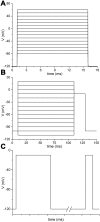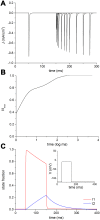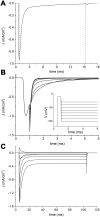A single Markov-type kinetic model accounting for the macroscopic currents of all human voltage-gated sodium channel isoforms
- PMID: 28863150
- PMCID: PMC5599066
- DOI: 10.1371/journal.pcbi.1005737
A single Markov-type kinetic model accounting for the macroscopic currents of all human voltage-gated sodium channel isoforms
Abstract
Modelling ionic channels represents a fundamental step towards developing biologically detailed neuron models. Until recently, the voltage-gated ion channels have been mainly modelled according to the formalism introduced by the seminal works of Hodgkin and Huxley (HH). However, following the continuing achievements in the biophysical and molecular comprehension of these pore-forming transmembrane proteins, the HH formalism turned out to carry limitations and inconsistencies in reproducing the ion-channels electrophysiological behaviour. At the same time, Markov-type kinetic models have been increasingly proven to successfully replicate both the electrophysiological and biophysical features of different ion channels. However, in order to model even the finest non-conducting molecular conformational change, they are often equipped with a considerable number of states and related transitions, which make them computationally heavy and less suitable for implementation in conductance-based neurons and large networks of those. In this purely modelling study we develop a Markov-type kinetic model for all human voltage-gated sodium channels (VGSCs). The model framework is detailed, unifying (i.e., it accounts for all ion-channel isoforms) and computationally efficient (i.e. with a minimal set of states and transitions). The electrophysiological data to be modelled are gathered from previously published studies on whole-cell patch-clamp experiments in mammalian cell lines heterologously expressing the human VGSC subtypes (from NaV1.1 to NaV1.9). By adopting a minimum sequence of states, and using the same state diagram for all the distinct isoforms, the model ensures the lightest computational load when used in neuron models and neural networks of increasing complexity. The transitions between the states are described by original ordinary differential equations, which represent the rate of the state transitions as a function of voltage (i.e., membrane potential). The kinetic model, developed in the NEURON simulation environment, appears to be the simplest and most parsimonious way for a detailed phenomenological description of the human VGSCs electrophysiological behaviour.
Conflict of interest statement
The authors have declared that no competing interests exist.
Figures









Similar articles
-
Phenomenological models of NaV1.5. A side by side, procedural, hands-on comparison between Hodgkin-Huxley and kinetic formalisms.Sci Rep. 2019 Nov 25;9(1):17493. doi: 10.1038/s41598-019-53662-9. Sci Rep. 2019. PMID: 31767896 Free PMC article.
-
Identification of structures for ion channel kinetic models.PLoS Comput Biol. 2021 Aug 16;17(8):e1008932. doi: 10.1371/journal.pcbi.1008932. eCollection 2021 Aug. PLoS Comput Biol. 2021. PMID: 34398881 Free PMC article.
-
Unusual Voltage-Gated Sodium Currents as Targets for Pain.Curr Top Membr. 2016;78:599-638. doi: 10.1016/bs.ctm.2015.12.005. Epub 2016 Feb 2. Curr Top Membr. 2016. PMID: 27586296 Review.
-
Benchmarking the stability of human detergent-solubilised voltage-gated sodium channels for structural studies using eel as a reference.Biochim Biophys Acta. 2015 Jul;1848(7):1545-51. doi: 10.1016/j.bbamem.2015.03.021. Epub 2015 Mar 30. Biochim Biophys Acta. 2015. PMID: 25838126 Free PMC article.
-
Voltage-gated sodium channels and pain-related disorders.Clin Sci (Lond). 2016 Dec 1;130(24):2257-2265. doi: 10.1042/CS20160041. Clin Sci (Lond). 2016. PMID: 27815510 Review.
Cited by
-
Modeling a Nociceptive Neuro-Immune Synapse Activated by ATP and 5-HT in Meninges: Novel Clues on Transduction of Chemical Signals Into Persistent or Rhythmic Neuronal Firing.Front Cell Neurosci. 2020 May 19;14:135. doi: 10.3389/fncel.2020.00135. eCollection 2020. Front Cell Neurosci. 2020. PMID: 32508598 Free PMC article.
-
Kilohertz waveforms optimized to produce closed-state Na+ channel inactivation eliminate onset response in nerve conduction block.PLoS Comput Biol. 2020 Jun 15;16(6):e1007766. doi: 10.1371/journal.pcbi.1007766. eCollection 2020 Jun. PLoS Comput Biol. 2020. PMID: 32542050 Free PMC article.
-
Modeling the Interactions Between Sodium Channels Provides Insight Into the Negative Dominance of Certain Channel Mutations.Front Physiol. 2020 Nov 5;11:589386. doi: 10.3389/fphys.2020.589386. eCollection 2020. Front Physiol. 2020. PMID: 33250780 Free PMC article.
-
Resurgent Na+ Current Offers Noise Modulation in Bursting Neurons.PLoS Comput Biol. 2019 Jun 21;15(6):e1007154. doi: 10.1371/journal.pcbi.1007154. eCollection 2019 Jun. PLoS Comput Biol. 2019. PMID: 31226124 Free PMC article.
-
Inactivation mode of sodium channels defines the different maximal firing rates of conventional versus atypical midbrain dopamine neurons.PLoS Comput Biol. 2021 Sep 17;17(9):e1009371. doi: 10.1371/journal.pcbi.1009371. eCollection 2021 Sep. PLoS Comput Biol. 2021. PMID: 34534209 Free PMC article.
References
-
- Hille B (1992) Ion Channels of Excitable Membranes. Sinauer Associates, Sunderland, MA.
-
- Southan C, Sharman JL, Benson HE, Faccenda E, Pawson AJ, Alexander SP, et al. The IUPHAR/BPS Guide to PHARMACOLOGY in 2016: towards curated quantitative interactions between 1300 protein targets and 6000 ligands. Nucleic Acids Res. 2016. January 4; 44(D1): D1054–68. doi: 10.1093/nar/gkv1037 - DOI - PMC - PubMed
-
- Traub RD, Contreras D, Cunningham MO, Murray H, LeBeau FE, Roopun A, et al. Single-column thalamocortical network model exhibiting gamma oscillations, sleep spindles, and epileptogenic bursts. J Neurophysiol. 2005. April; 93(4): 2194–232. doi: 10.1152/jn.00983.2004 - DOI - PubMed
-
- Rybak IA, Shevtsova NA, Lafreniere-Roula M, McCrea DA. Modelling spinal circuitry involved in locomotor pattern generation: insights from deletions during fictive locomotion. J Physiol. 2006. December 1; 577(Pt 2): 617–39. doi: 10.1113/jphysiol.2006.118703 - DOI - PMC - PubMed
MeSH terms
Substances
LinkOut - more resources
Full Text Sources
Other Literature Sources
Molecular Biology Databases

